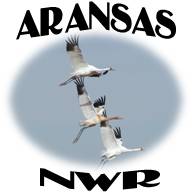By: Chester McConnell, Whooping Crane Conservation Association
Whooping cranes are currently (11/23/2011) continuing to migrate from their nesting habitat in Canada to their winter habitat in the United States. Martha C. Tacha, U.S. Fish and Wildlife Service, Grand Island, NE is responsible compiling records of whooping crane sightings along the migration route. Tacha reports, “There are a still a few whooping cranes in the flyway. A single adult-plumaged bird was spotted at Quivira NWR and another at Salt Plains NWR. Only 43 whoopers have been confirmed north of Kansas since 11/9/2011. Interestingly, two additional single-parent families were detected and photographed. That makes three families with only one parent observed and photographed in the flyway this migration, which is both uncommon and troubling. Unfortunately, one of the GPS-marked juveniles was found dead west
central Kansas and cause of death is unknown at this time.”
Dan Alonso, Refuge Manager, Aransas National Wildlife Refuge estimated 80 percent (240) of the whoopers have now reached the refuge along the Texas coast. Eighteen of the 20 whoopers with GPS monitors attached have also reached the refuge. An aerial census is planned for next week to get a more definite count.
During their 2,400 mile southward migration, the cranes take their time, stopping periodically to feed in agricultural fields and wetlands. The southward migration will soon be completed and the whoopers will settled down for the winter on Aransas National Wildlife Refuge. Then when the spring season arrives, the birds will migrate back to their nesting habitat in Canada. Whooping cranes have followed this schedule for thousands of years.
The whooping crane’s natural habitats are essential to their survival. Until about the 1400’s, whooping cranes ranged across much of central North America, from as far north as Canada’s Northwest Territories to the southern coast of Texas. Though never believed to be abundant, their numbers were thought to be around 1,500 in the mid-1800. As European’s immigrated to North America in large numbers, their settlement and developments destroyed much of the whoopers nesting and winter habitats. Unregulated hunting also contributed to the whooper population decline. By the 1940s the whooping crane population had dropped to an all-time low of 15 birds. Aided by
protection and habitat management the original wild migratory flock has slowly recovered and now numbers approximately 300.
Currently, however, family units and small groups of juvenile whoopers continue their leisurely southward journey. They are headed to Aransas National Wildlife Refuge. The wintering habitat of the last remaining wild migratory flock of whooping cranes in the world is located in on Aransas Refuge on the central coast of Texas, USA.
Aransas was originally established by President Franklin Roosevelt in 1937 as a “refuge and breeding ground for migratory birds and other wildlife… and to conserve fish or wildlife which are listed as endangered or threatened species…”
The Aransas Refuge complex is comprised of over 115,000 acres including the Blackjack Peninsula (Aransas proper), Matagorda Island, and the Myrtle Foester Whitmire, Tatton, and Lamar units. These areas provide essential wintering habitat for the endangered whooping cranes in addition to vital resting, feeding, wintering, and nesting grounds for a wide assortment of migratory birds and native Texas wildlife.
The nesting habitat of the last remaining wild migratory flock of whooping cranes is located in Wood Buffalo National Park, Canada. Approximately 11 million acres (17,300 sq. mi.) in size, Wood Buffalo National Park is Canada’s largest national park and one of the largest parks in the world. The park was established in 1922 to protect the
free-roaming bison herds of the area. Now the park also focuses on supporting and protecting many unique natural and cultural resources, from diverse ecosystems and rare species like whooping cranes to the traditional activities of Aboriginal residents. During the 2011 nesting season wildlife biologist recorded 75 whooping crane nests on Wood Buffalo. Approximately 37 chicks fledged from the record 75 nests in August 2011. Due to this successful nesting season, the flock size may reach record levels of around 300 this fall.

 The whooping crane – the tallest bird in North America and one of the rarest – is the leading symbol of wildlife-conservation efforts in the United States. In 1941, the species’ total population had dwindled to 15 cranes, discovered wintering on the Texas coast. The American Birding Association reported a species population of 599 last September, including 278 cranes in the group that migrates 2,500 miles between nesting grounds in Canada’s Wood Buffalo National Park and wintering habitat around Texas’ San Antonio Bay, north of Corpus Christi.
The whooping crane – the tallest bird in North America and one of the rarest – is the leading symbol of wildlife-conservation efforts in the United States. In 1941, the species’ total population had dwindled to 15 cranes, discovered wintering on the Texas coast. The American Birding Association reported a species population of 599 last September, including 278 cranes in the group that migrates 2,500 miles between nesting grounds in Canada’s Wood Buffalo National Park and wintering habitat around Texas’ San Antonio Bay, north of Corpus Christi.




